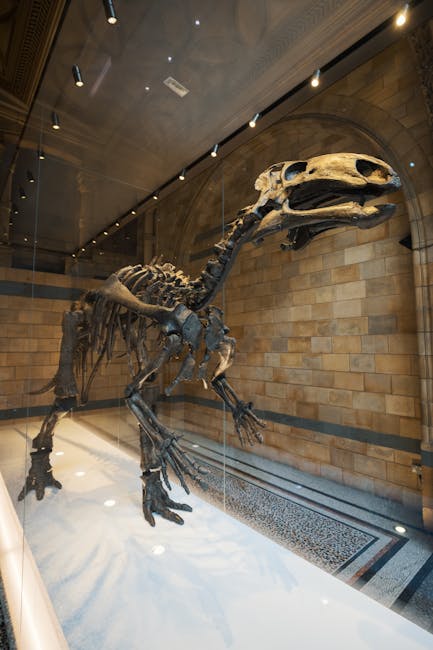Unearthing Dinosaurs: How Lichen Could Reveal Hidden Fossil Sites

Unearthing Dinosaurs: How Lichen Could Reveal Hidden Fossil Sites

The quest to unearth the ancient giants and fascinating creatures of Earth’s past is a continuous challenge for paleontologists. Hidden beneath layers of soil, rock, and vegetation, fossil sites often remain elusive, requiring extensive geological knowledge and painstaking effort to locate. Traditional methods, while effective, can be time-consuming, costly, and sometimes miss subtle indicators of buried treasures. However, a revolutionary approach is emerging from an unexpected corner of the natural world: lichen. These unassuming symbiotic organisms, long overlooked in the grand scheme of fossil discovery, may hold the key to pinpointing previously unknown fossil-rich deposits. By understanding how lichen interacts with its substrate, scientists could unlock a powerful new tool in the ongoing global hunt for dinosaur bones and other prehistoric remains.
The geological detective work of paleontology
For centuries, the search for fossils has been a meticulous blend of geological expertise, intuition, and sheer perseverance. Paleontologists typically begin their hunt by identifying areas with suitable sedimentary rock formations, knowing that these are the most likely places to preserve ancient life. They scour exposed rock faces, often in badlands or areas with significant erosion, looking for tell-tale signs like bone fragments, petrified wood, or distinctive rock coloration. Geological maps, satellite imagery, and even historical records guide these expeditions. However, much of the Earth’s surface remains covered by soil, dense vegetation, or modern sediments, effectively masking the underlying fossil-bearing strata. Discovering new sites often relies on chance encounters—a farmer plowing a field, a road cut, or a rare severe weather event exposing new rock. This reliance on visible outcrops and the inherent difficulty of penetrating dense ground cover underscore the need for innovative, non-invasive methods to peer beneath the surface and reveal hidden paleontological potential.
Lichen: nature’s resilient pioneers
Lichen, often mistaken for moss or simply a stain on rocks, is in fact a fascinating symbiotic organism—a partnership between a fungus and an alga or cyanobacterium. This unique collaboration allows lichen to thrive in some of the planet’s most extreme environments, from polar tundras to arid deserts, clinging to bare rock, tree bark, and even man-made structures. They are true pioneer species, capable of colonizing surfaces where little else can survive. One of lichen’s critical ecological roles is its interaction with its substrate. Through the secretion of organic acids and the physical action of its thallus (body), lichen contributes significantly to the weathering of rocks. It extracts nutrients directly from the rock and the air, accumulating various minerals and elements within its tissues. This intimate and continuous chemical exchange with the underlying geology makes lichen a living indicator, potentially reflecting the unique mineralogical signatures of the rocks upon which it grows.
How lichen interacts with bedrock and hints at ancient life
The potential for lichen to reveal hidden fossil sites lies in its capacity to respond to the specific chemical composition of the rock it colonizes. Fossil-rich sedimentary rocks, particularly those containing significant bone beds, often have elevated concentrations of certain elements, most notably phosphate. Bones and teeth are primarily composed of calcium phosphate, and as these decompose and fossilize, they impregnate the surrounding sediments with these phosphorus compounds. Lichen growing on such phosphate-enriched substrates might exhibit distinct characteristics. This could manifest as altered growth rates, unique morphological patterns, or, crucially, subtle but detectable changes in their color or spectral reflectance. For instance, some studies suggest that lichen thriving on rocks with higher mineral content might display different pigments or biomass density, which can be observed using specialized imaging techniques. The lichen effectively acts as a biological sensor, subtly changing its “expression” in response to the unusual chemistry of a fossiliferous deposit, providing a natural, visual proxy for what lies beneath.
The potential and practical application in fossil prospecting
Leveraging lichen’s bio-indicator capabilities presents an exciting frontier for paleontological prospecting. The practical application would likely involve a multi-stage approach, combining remote sensing with targeted ground investigation. Initially, drones equipped with hyperspectral cameras could survey large, inaccessible areas. These cameras can detect subtle variations in the spectral signature of lichen that are invisible to the naked eye, identifying anomalies that might correspond to phosphate-rich or otherwise mineralogically distinct fossil beds. These “hotspots” could then be prioritized for ground-truthing. Field paleontologists would visit these specific locations to collect lichen samples and conduct geological surveys, analyzing the lichen’s biochemical composition for elevated phosphate levels or other indicative elements, and examining the underlying rock for fossil evidence. This method offers a non-invasive way to narrow down vast search areas, reducing the time, labor, and environmental impact associated with traditional blanket surveys.
| Methodology | Key Benefit | Primary Challenge | Detection Mechanism |
|---|---|---|---|
| Traditional Geological Survey | Direct observation of outcrops | Limited by surface exposure | Visual identification of fossils/strata |
| Remote Sensing (e.g., Lidar, Satellite) | Large-area coverage, topographical insights | Doesn’t directly indicate fossils under cover | Geomorphological patterns |
| Lichen-Assisted Prospecting | Bio-indication of buried mineralogy | Requires validation of lichen signals | Spectral/biochemical response of lichen to rock chemistry |
The innovative concept of using lichen as a biological guide in the search for hidden fossil sites holds immense promise for the field of paleontology. By recognizing these resilient organisms not just as simple rock dwellers, but as dynamic indicators of underlying geology, scientists could revolutionize the discovery process. This method offers a non-invasive, potentially cost-effective, and highly targeted approach to pinpointing previously elusive bone beds, significantly expanding our ability to uncover Earth’s prehistoric secrets. While still an emerging field requiring further research and validation, the intricate relationship between lichen and its substrate opens up exciting new avenues. Future exploration will undoubtedly refine our understanding of these interactions, potentially leading to a new era of paleontological discovery, where tiny, ancient life forms help us find giants from the deep past.
No related posts
Image by: Matheus Bertelli
https://www.pexels.com/@bertellifotografia

